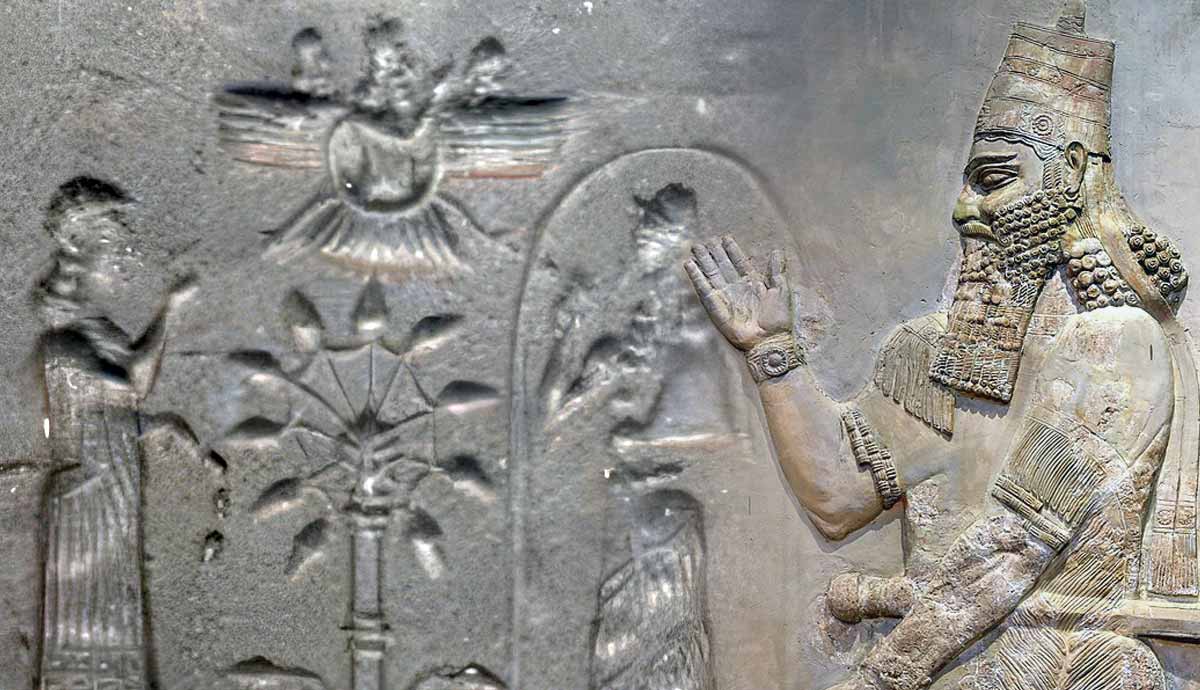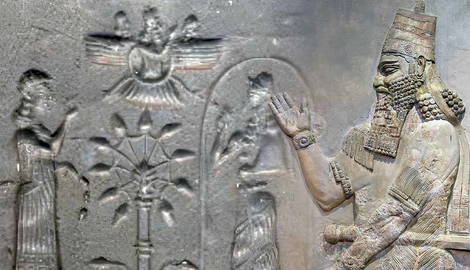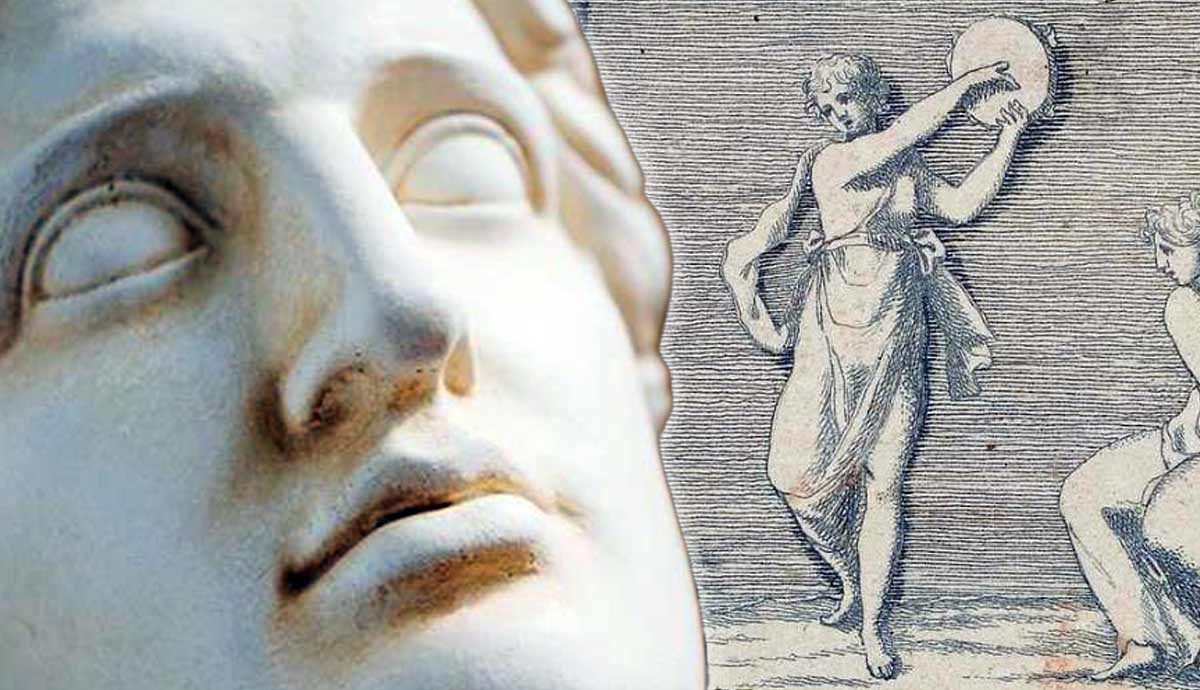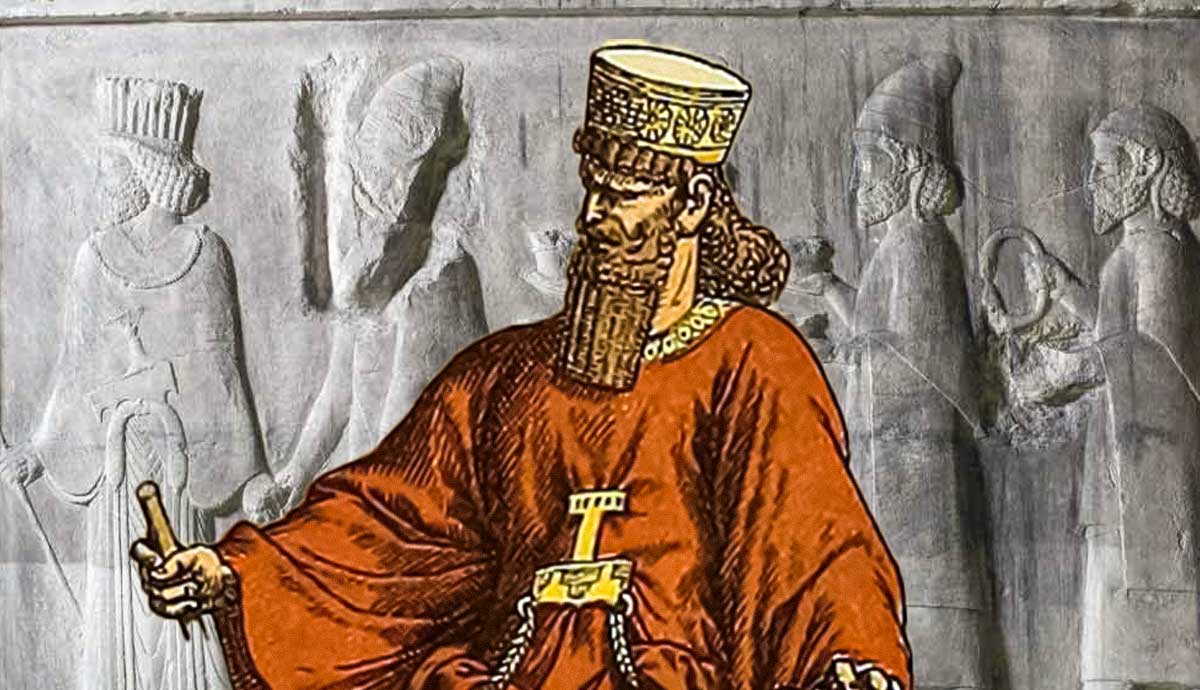
Religious policies have been utilized by monarchies and governments for political gains since the beginning of civilization. Few have done so as successfully as the Neo-Assyrian Empire. The kings of both the Old and Middle Assyrian periods provided their successors with the powerful framework that the Neo-Assyrian rulers used to subjugate other kingdoms across the Near East and become the biggest empire the world had seen until that point. Their ideology appointed their king as the representative of the gods on earth, and the gods wanted Assyria to expand and dominate the known world.
In the Beginning: Early Assyrian History

For the most part, the Old Assyrian Kingdom (c. 2025-1364 BCE) was an inconsequential city-state named Assur. The rulers from this period were not kings at all, but titled “Išši’ak Assur” or “governors on behalf of Assur,” the city’s patron deity. Over time, Assur rose to become a prominent trading hub, but this was notably accelerated when the Amorite leader Shamshi-Adad I conquered the city.
Shamshi-Adad I ruled over a small, short-lived empire that encompassed the city of Assur, but this fell apart after his death. The rest of the Old Assyrian period was plagued by unrest, including hostile takeovers from neighboring city-states and internal factions fighting for power. By 1700 BCE, Assyria was once again independent and somewhat stable.
For a brief period, Assur was made a vassal of the Mitanni, but it quickly regained independence when the Mitanni Empire collapsed just 70 years later. During this time, the line of kings that established itself in 1700 BCE, the Adaside dynasty, was still the city’s leader. Assur’s break from the Mitanni in c. 1360 BCE and subsequent territorial gains in the region are what historians use to divide the Old Assyrian and Middle Assyrian periods.
While fierce kingship is not yet overt in the history of Assur, the hallmarks of later tactics employed to subjugate are already apparent. The original title, “governors on behalf of Assur,” clearly illustrates the direct connection between the Assyrian king and the city’s patron deity of the same name. Moreover, archaeological evidence from the city before the Old Assyrian period shows that Ishtar was the city’s patron goddess. However, the city of Assur was eventually deified as a god of the same name.
The Highs and Lows of the Middle Assyrian Empire

The Middle Assyrian period is when the city-state finally reached the status of an empire. Under the reign of the first king of the era, Ashur-uballit I, Assyria began to conquer the surrounding lands. His successors, principally his great-great-great-grandson Tukulti-Ninurta I, cemented Assyrian power in the ancient Near East. It was during the leadership of Tukulti-Ninurta I that the Middle Assyrian Empire reached its zenith.
Tukulti-Ninurta, in particular, proved the benefits of having a warrior king instead of the traditional priest-king. Tukulti-Ninurta I brought the conflict with the Hittites, which his father had originally started, to a close with a decisive Assyrian victory before shifting his focus to Babylonia in a campaign claimed to be sanctified by the gods.
In the Tukulti-Ninurta Epic, an Assyrian epic written in the 13th century BCE, he claimed that the Babylonians had attacked Assyrian territories and that their ruler, Kashtiliash IV, had been forsaken by the gods. This narrative was likely crafted as state-sponsored propaganda to legitimize Assyrian aggression. In 1225 BCE, Tukulti-Ninurta I emerged victorious in the Babylonian campaign, though contemporary accounts suggest the triumph came at a significant cost. Many of the territories conquered in Babylonia were governed indirectly, often through the appointment of vassal kings.

Tukulti-Ninurta I initially demonstrated his appreciation for Babylonian culture by visiting Babylon and making offerings to its gods. However, this period of cordial relations did not endure. In 1217 BCE, he launched a third military campaign against Babylonia after Adad-shuma-iddina, a Babylonian vassal king, rebelled against Assyrian authority for the second time.
During this campaign, Babylon was plundered and its sacred sites defiled. Tukulti-Ninurta I also seized a prominent statue of Marduk, the city’s chief deity, and transported it to Assyria; a move that was deeply unpopular among his people. Tukulti-Ninurta I was later assassinated due to his waning popularity with the public, which had grown frustrated with his failure to maintain good relations with foreign powers and newly conquered territories, such as Babylon, which had mounted a successful rebellion.
After the death of Tukulti-Ninurta I, Assyrian power largely dwindled. It was not until the reign of Ashur-dan II, from c. 934-912 BCE, that the Assyrian prowess began to reinforce itself again. His son, Adad-nirari II, would mark the start of the Neo-Assyrian Empire.
Partnership With Assyrian Deities

The reign of Tukulti-Ninurta I was a hallmark of what was to come in the arsenal of Neo-Assyrian subjugation. Before his war with Babylon, Tukulti-Ninurta I presented himself as the king who would restore the will of the gods, thereby justifying his attack. The relationship between the Assyrian ruler and the Assyrian pantheon had been notable since the start of the Old Assyrian period, when the leader was given the title “governor on behalf of Assur.”
By the height of the Neo-Assyrian Empire, the king was essentially the mouthpiece of the gods, acting as their representative on earth. The Assyrians had adopted the ancient concept of divine kingship from the Sumerians and Akkadians, and it is constantly emphasized in art and inscriptions from that time.

This is evident from royal inscriptions such as Ashurbanipal’s Hymn to Aššur, where multiple notions surrounding divine kingship are unearthed. Firstly, the key act of mediating is clearly illustrated when Ashurbanipal states that he is the “GÌR.NÍTA” or representative of Assur. Consequently, it is explicit from this title and multiple others that Assur was seen as the real king of Assyria, while the ruling king was merely his agent. In Ashurbanipal’s Coronation Hymn, he states Assur is king and he is again the “representative.”
From birth, the masculinity of a king was also reflected in his relationship with the gods, particularly with Ishtar, who is often described as the wet nurse of kings. Ashurbanipal claimed he feared nothing, as Ishtar was his wet nurse, and his father Esarhaddon stated that not only was she his wet nurse but also his midwife.
Warrior Gods

While the Assyrian king was seen as a holy man with a deep, multifaceted connection to the Assyrian pantheon, he was also a fearsome warrior on their behalf. This was a reflection of their gods themselves, who were also considered warriors. His relationship with the gods reinforced the idea of the king as a formidable warrior, even in his relationship with the goddess Ishtar.
Ishtar was the only female deity the king was associated with, and she was also associated with royal women. Her scorpion iconography can be found on objects belonging to these imperial women. However, the scorpion effigy represents the goddess Ishara, also known as Ishtar in her married form. Needless to say, only the unmarried Ishtar was associated with the king.
Furthermore, Ishtar was a female deity who came to convey masculine ideals, evidently making her mothership invaluable to a growing warrior king. She represented uncontrollable forces such as sex and war, which elicit passion and power, two components essential to Assyrian masculinity and crucial for a leader in warfare. Additionally, Ishtar was the original patron of Assur and thus bound the king to an ancient and therefore rightful lineage.

The Assyrian king also routinely identified himself with other warrior gods, especially Ninurta and Nergal. The mythology surrounding Ninurta implied that conflict was considered an eternal act of creation and therefore integral to Assyrian culture. When Ninurta destroyed Anzu in the creation myth, he established cosmic order. This meant that the king would essentially replicate this process when conquering foreign lands.
In multiple instances, warrior deities such as Ninurta, Nergal, and Ninlil bestow some sort of divine insignia on the king. In Ninurta’s Letter to an Assyrian King, he not only gives the king his “HATTU” (scepter) but also the throne. In coronation rituals, the weapons of either Assur, Ninurta, or Ninlil were given to the king, as exhibited in Ashurbanipal’s Coronation Hymn. Moreover, this specific hymn finishes by asking the gods to grant the king a blessed reign with “strong weapons.”
Warrior Kings

The significance of connecting the Assyrian king to a host of warrior deities manifested in the plight of the Assyrian gods, who instructed their earthly representative to bring more chaotic foreign lands under their control. Historians are unsure whether the influence of the increasingly militaristic gods sparked the actions of the expansionist king or vice versa.
By the height of the Neo-Assyrian Empire, the idea of the king as a warrior working on behalf of the gods was firmly entrenched. This is clear in multiple cultic rituals before and after the battle, including the washing of their divine “KAKKU” (weapons).

Similarly, this is evident in contemporary iconography, such as on the Black Obelisk of Shalmaneser. It contains 20 relief scenes, five of which depict the subjugated rival kings. Above these scenes are the symbols of Ishtar and Assur. The inscription praises the gods before detailing various violent military campaigns, where Shalmaneser uses phrases such as “victims for my gods I took” and “by the command of Aššur I fought them.”
Religion as a Means to Subjugate

The combination of religious piety with militaristic emphasis can be seen clearly in the idea of the Assyrian king as a shepherd of the people, both the Assyrian public and the royalty and subjects of other states. In Ashurbanipal’s Coronation Hymn, the first line tells us that the gods bestowed shepherdship upon him to rule over the four regions, and in the final line, Ashurbanipal is given the weapon of war and commanded to rule as a shepherd.
The Assyrians afforded themselves an element of guardianship over their client states and, in simple terms, portrayed the expansionist actions as a benefit to the subjugated people. Conversely, the punishment enacted during war was deemed to be caused by the citizens’ failure to properly worship their deities. For example, Ashurbanipal stated that Shamash-shum-ukin, King of Babylon, was abandoned by the Babylonian gods, who departed to foreign lands.
As Assyrian territory expanded, the Assyrian king was embedded in ancient Near-Eastern mythology. The influence of earlier Babylonian and Sumerian religious traditions on Assyrian theogony and cosmogony is well documented. In essence, the Assyrians adopted many elements from Babylonian mythology but restructured them to place their own chief deity, Assur, at the head of the divine hierarchy.
The king was often mythologized through “factual” official documents, just as gods and legendary warriors were in traditional epics. Through this, the king possessed many qualities shared with the gods, which enforced the king’s unwavering supremacy. Furthermore, the Assyrian pantheon appeared to be directly linked to violence wherever possible. Their individual mythologies, weapons, and iconography on imperial stelae justified the king and the army’s violent actions.
Enemy of Foreign Deities

Through mythological domination, the Assyrians were able to consolidate an ideological program that emphasized expansion on behalf of the deities. The position of Assur as the Assyrian “Enlil” or chief god of all Near Eastern pantheons, at least from an Assyrian perspective, placed the king as the most powerful divine intercessor in the known world. The Assyrians attempted to shrug off the more established Babylonian traditions by adapting the same mythologies to show Assyrian hegemony.
However, the relationship between the Assyrian king and foreign deities, and therefore foreign states, was deeply complex. Although the Assyrian king ultimately had to display his authority over external lands, the destruction of religious beliefs and cultic objects was rarely the first tactic employed in warfare.
Under Assyrian rule, particularly if a kingdom submitted without battle, the general populace was allowed to practice their own religions. Likewise, the Assyrians seemingly believed in the presence of deities outside their pantheons as the Assyrians followed the tradition of swearing oaths in front of not only their gods but the gods of others, for example, in Esarhaddon’s Treaty with Baal, King of Tyre.

The Assyrians were generally accepting of the deities of neighboring kingdoms, even occasionally incorporating some into their own doctrine. However, the king’s attitudes towards these deities could swiftly change, particularly if vassal states were to rebel. Many boasted about kidnapping the gods of other states. In the inscription on the Black Obelisk of Shalmaneser III, he recalls taking the gods from no less than three different cities.
Godnapping, the theft of foreign idols, was a strategy employed just as human hostages were taken. Policies specifically attacking the religion of foreign states seem to have only been used when drastic action was needed or as a last resort. Moreover, the Neo-Assyrian people appeared to have held at least some foreign idols in high regard, hence their worship once they were brought to Assyria.
Imperialism to the End

But religious violence did take place often with dramatic repercussions. During conflicts with Urartu, Sargon II plundered the temple of their chief god, Haldi, in the capital of Musasir because three different deities commanded it. Nevertheless, the most noteworthy incidents of religious violence and psychological warfare inflicted by the Assyrians were against Babylon.
There was an extensive cult for the Babylonian chief god Marduk in Assyria, while there is very little mention of Assur anywhere outside of Assyria, and no mention of his cult in Babylonia at all. This indicates that the Assyrians showed a level of respect for Babylonian traditions, a sentiment that was not returned by the Babylonians.
Additionally, it highlighted the challenge for the new power, Assyria, to assert dominance. The widespread reverence for Babylonian deities made it clear that Babylonia held greater recognition and prestige across the broader multicultural landscape. King Sennacherib had attempted to subdue the restless city of Babylon multiple times throughout his 24-year reign, which resulted in the absolute destruction of the cultural hub. Sennacherib mercilessly razed temples, sanctuaries, and other religious sites and artworks.

Sennacherib’s destruction of Babylon caused considerable unrest within Assyria, prompting the king to justify his actions through a myth portraying Marduk being judged by the Assyrian god Assur. Sennacherib declared Assur the new central god in the Babylonian New Year celebrations, which again emphasized the Assyrian methodology of subjugation by the utilization of religious ideology.
Overall, the Neo-Assyrians dominated the ancient Near Eastern political landscape, largely through their strategic use of state religion. Their empire was a divinely sanctioned kingdom, ruled by a divinely chosen king, which justified all imperial actions. The Assyrian king was in a position where religious doctrine not only encouraged but also compelled territorial expansion.










